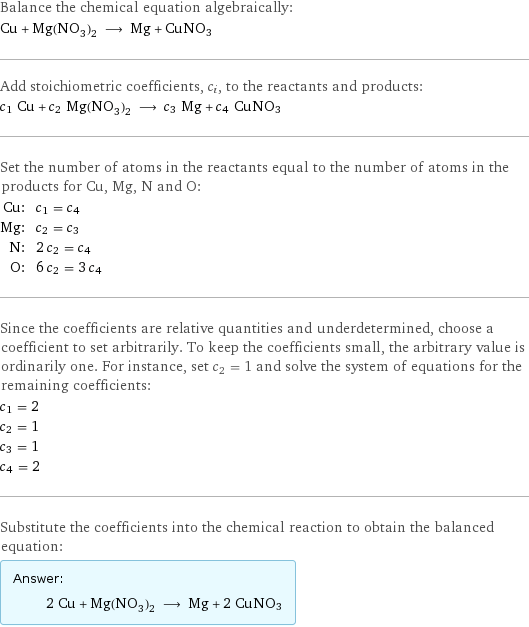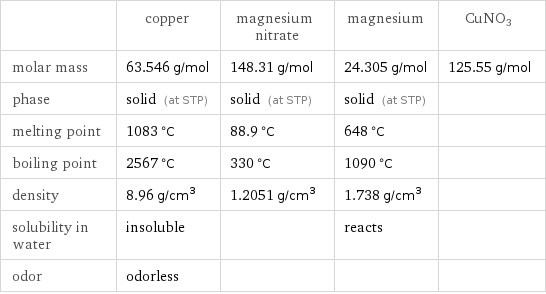Input interpretation

Cu copper + Mg(NO_3)_2 magnesium nitrate ⟶ Mg magnesium + CuNO3
Balanced equation

Balance the chemical equation algebraically: Cu + Mg(NO_3)_2 ⟶ Mg + CuNO3 Add stoichiometric coefficients, c_i, to the reactants and products: c_1 Cu + c_2 Mg(NO_3)_2 ⟶ c_3 Mg + c_4 CuNO3 Set the number of atoms in the reactants equal to the number of atoms in the products for Cu, Mg, N and O: Cu: | c_1 = c_4 Mg: | c_2 = c_3 N: | 2 c_2 = c_4 O: | 6 c_2 = 3 c_4 Since the coefficients are relative quantities and underdetermined, choose a coefficient to set arbitrarily. To keep the coefficients small, the arbitrary value is ordinarily one. For instance, set c_2 = 1 and solve the system of equations for the remaining coefficients: c_1 = 2 c_2 = 1 c_3 = 1 c_4 = 2 Substitute the coefficients into the chemical reaction to obtain the balanced equation: Answer: | | 2 Cu + Mg(NO_3)_2 ⟶ Mg + 2 CuNO3
Structures

+ ⟶ + CuNO3
Names

copper + magnesium nitrate ⟶ magnesium + CuNO3
Equilibrium constant
![Construct the equilibrium constant, K, expression for: Cu + Mg(NO_3)_2 ⟶ Mg + CuNO3 Plan: • Balance the chemical equation. • Determine the stoichiometric numbers. • Assemble the activity expression for each chemical species. • Use the activity expressions to build the equilibrium constant expression. Write the balanced chemical equation: 2 Cu + Mg(NO_3)_2 ⟶ Mg + 2 CuNO3 Assign stoichiometric numbers, ν_i, using the stoichiometric coefficients, c_i, from the balanced chemical equation in the following manner: ν_i = -c_i for reactants and ν_i = c_i for products: chemical species | c_i | ν_i Cu | 2 | -2 Mg(NO_3)_2 | 1 | -1 Mg | 1 | 1 CuNO3 | 2 | 2 Assemble the activity expressions accounting for the state of matter and ν_i: chemical species | c_i | ν_i | activity expression Cu | 2 | -2 | ([Cu])^(-2) Mg(NO_3)_2 | 1 | -1 | ([Mg(NO3)2])^(-1) Mg | 1 | 1 | [Mg] CuNO3 | 2 | 2 | ([CuNO3])^2 The equilibrium constant symbol in the concentration basis is: K_c Mulitply the activity expressions to arrive at the K_c expression: Answer: | | K_c = ([Cu])^(-2) ([Mg(NO3)2])^(-1) [Mg] ([CuNO3])^2 = ([Mg] ([CuNO3])^2)/(([Cu])^2 [Mg(NO3)2])](../image_source/3e25698037cce67f67166e590133b3fa.png)
Construct the equilibrium constant, K, expression for: Cu + Mg(NO_3)_2 ⟶ Mg + CuNO3 Plan: • Balance the chemical equation. • Determine the stoichiometric numbers. • Assemble the activity expression for each chemical species. • Use the activity expressions to build the equilibrium constant expression. Write the balanced chemical equation: 2 Cu + Mg(NO_3)_2 ⟶ Mg + 2 CuNO3 Assign stoichiometric numbers, ν_i, using the stoichiometric coefficients, c_i, from the balanced chemical equation in the following manner: ν_i = -c_i for reactants and ν_i = c_i for products: chemical species | c_i | ν_i Cu | 2 | -2 Mg(NO_3)_2 | 1 | -1 Mg | 1 | 1 CuNO3 | 2 | 2 Assemble the activity expressions accounting for the state of matter and ν_i: chemical species | c_i | ν_i | activity expression Cu | 2 | -2 | ([Cu])^(-2) Mg(NO_3)_2 | 1 | -1 | ([Mg(NO3)2])^(-1) Mg | 1 | 1 | [Mg] CuNO3 | 2 | 2 | ([CuNO3])^2 The equilibrium constant symbol in the concentration basis is: K_c Mulitply the activity expressions to arrive at the K_c expression: Answer: | | K_c = ([Cu])^(-2) ([Mg(NO3)2])^(-1) [Mg] ([CuNO3])^2 = ([Mg] ([CuNO3])^2)/(([Cu])^2 [Mg(NO3)2])
Rate of reaction
![Construct the rate of reaction expression for: Cu + Mg(NO_3)_2 ⟶ Mg + CuNO3 Plan: • Balance the chemical equation. • Determine the stoichiometric numbers. • Assemble the rate term for each chemical species. • Write the rate of reaction expression. Write the balanced chemical equation: 2 Cu + Mg(NO_3)_2 ⟶ Mg + 2 CuNO3 Assign stoichiometric numbers, ν_i, using the stoichiometric coefficients, c_i, from the balanced chemical equation in the following manner: ν_i = -c_i for reactants and ν_i = c_i for products: chemical species | c_i | ν_i Cu | 2 | -2 Mg(NO_3)_2 | 1 | -1 Mg | 1 | 1 CuNO3 | 2 | 2 The rate term for each chemical species, B_i, is 1/ν_i(Δ[B_i])/(Δt) where [B_i] is the amount concentration and t is time: chemical species | c_i | ν_i | rate term Cu | 2 | -2 | -1/2 (Δ[Cu])/(Δt) Mg(NO_3)_2 | 1 | -1 | -(Δ[Mg(NO3)2])/(Δt) Mg | 1 | 1 | (Δ[Mg])/(Δt) CuNO3 | 2 | 2 | 1/2 (Δ[CuNO3])/(Δt) (for infinitesimal rate of change, replace Δ with d) Set the rate terms equal to each other to arrive at the rate expression: Answer: | | rate = -1/2 (Δ[Cu])/(Δt) = -(Δ[Mg(NO3)2])/(Δt) = (Δ[Mg])/(Δt) = 1/2 (Δ[CuNO3])/(Δt) (assuming constant volume and no accumulation of intermediates or side products)](../image_source/ee4d461d87b215cecee85a4ee503f048.png)
Construct the rate of reaction expression for: Cu + Mg(NO_3)_2 ⟶ Mg + CuNO3 Plan: • Balance the chemical equation. • Determine the stoichiometric numbers. • Assemble the rate term for each chemical species. • Write the rate of reaction expression. Write the balanced chemical equation: 2 Cu + Mg(NO_3)_2 ⟶ Mg + 2 CuNO3 Assign stoichiometric numbers, ν_i, using the stoichiometric coefficients, c_i, from the balanced chemical equation in the following manner: ν_i = -c_i for reactants and ν_i = c_i for products: chemical species | c_i | ν_i Cu | 2 | -2 Mg(NO_3)_2 | 1 | -1 Mg | 1 | 1 CuNO3 | 2 | 2 The rate term for each chemical species, B_i, is 1/ν_i(Δ[B_i])/(Δt) where [B_i] is the amount concentration and t is time: chemical species | c_i | ν_i | rate term Cu | 2 | -2 | -1/2 (Δ[Cu])/(Δt) Mg(NO_3)_2 | 1 | -1 | -(Δ[Mg(NO3)2])/(Δt) Mg | 1 | 1 | (Δ[Mg])/(Δt) CuNO3 | 2 | 2 | 1/2 (Δ[CuNO3])/(Δt) (for infinitesimal rate of change, replace Δ with d) Set the rate terms equal to each other to arrive at the rate expression: Answer: | | rate = -1/2 (Δ[Cu])/(Δt) = -(Δ[Mg(NO3)2])/(Δt) = (Δ[Mg])/(Δt) = 1/2 (Δ[CuNO3])/(Δt) (assuming constant volume and no accumulation of intermediates or side products)
Chemical names and formulas

| copper | magnesium nitrate | magnesium | CuNO3 formula | Cu | Mg(NO_3)_2 | Mg | CuNO3 Hill formula | Cu | MgN_2O_6 | Mg | CuNO3 name | copper | magnesium nitrate | magnesium | IUPAC name | copper | magnesium dinitrate | magnesium |
Substance properties

| copper | magnesium nitrate | magnesium | CuNO3 molar mass | 63.546 g/mol | 148.31 g/mol | 24.305 g/mol | 125.55 g/mol phase | solid (at STP) | solid (at STP) | solid (at STP) | melting point | 1083 °C | 88.9 °C | 648 °C | boiling point | 2567 °C | 330 °C | 1090 °C | density | 8.96 g/cm^3 | 1.2051 g/cm^3 | 1.738 g/cm^3 | solubility in water | insoluble | | reacts | odor | odorless | | |
Units
